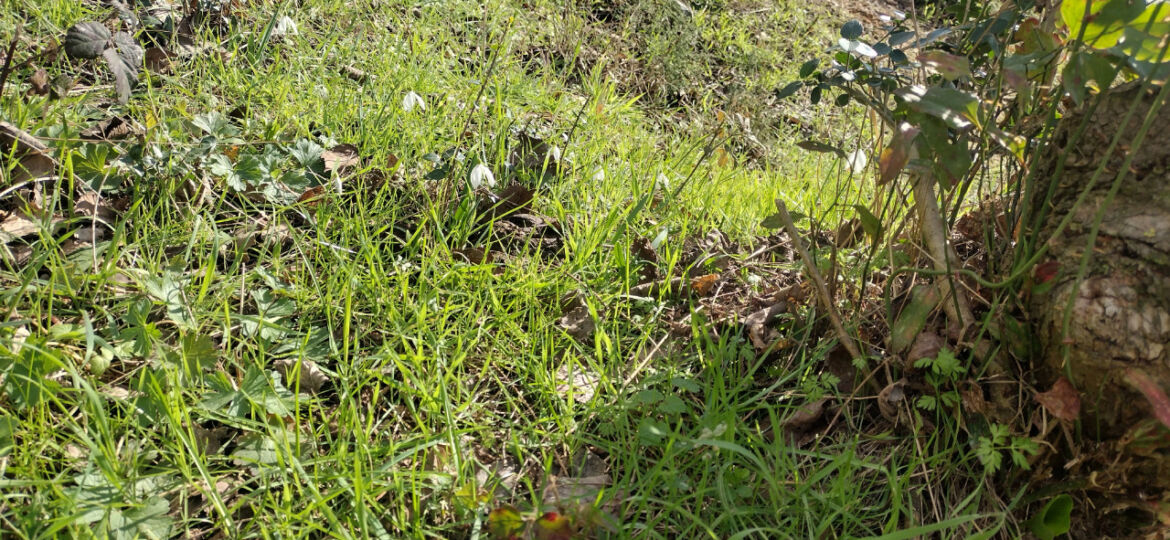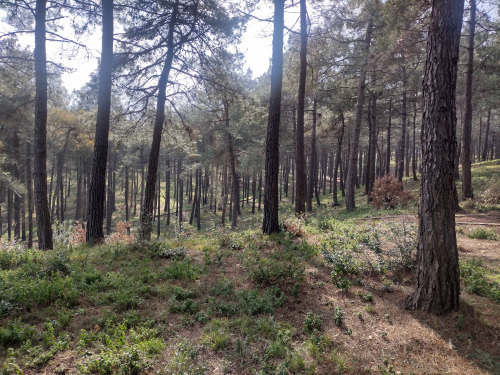
Living at ANAMED at the heart of a historic metropolis of 16 million people has many advantages. However, one notable drawback is the lack of easy access to substantial areas of green space, with many of the parks within easy walking distance of ANAMED lacking in size, quantity of vegetation, and seclusion from the noise of the city. In search of spaces to get back to nature, I’ve spent much of my free time here so far finding and exploring a number of the city’s recently established “Kent Ormanılar,” or city forests. Conscious of the current climate crisis, I’ve tried to access all of these using only public transport. I present a brief guide to my favorites below.
Atatürk Kent Ormanı
Time from ANAMED: About 30 minutes
How to get there: Walk from ANAMED to Şişhane metro station. Take the M2 line north towards Hacıosman. Get off at either Darüşşafaka station, to access the forest park from the south, or at Hacıosman, to access it from the north. In both stations, there are signs marked “Atatürk Kent Ormanı” to lead you to the right exit.
What you’ll find there: The park is nestled in a small valley leading down to a lake on the eastern side. Although relatively small, the placement of the valley effectively blocks out much of the surrounding traffic noise and enhances the feeling of seclusion. The paths are generally well laid and maintained, making them suitable for easy cycling. You can walk between the metro stations on a flat path in only 20 minutes, but the steep slopes of the valley mean that exploring all of the park’s routes takes over an hour.
Areas for improvement: The signs say you’re not allowed to feed the ducks in the lake, although I’ve never seen this stop anyone. Despite the suitability of the paths for cycling, I’ve seen nowhere nearby where you can rent bikes. The park’s small size and ease of access on the metro means it can be relatively crowded on a nice day as compared to the others listed here.
Kemerburgaz Kent Ormanı
Time from ANAMED: About 1 hour and 15 minutes
How to get there: Walk from ANAMED to Şişhane metro station. Take the M2 line north towards Hacıosman. Get off the M2 at Şişli/Mecdiyeköy and change to the M7 line, heading in the direction of Mahmutbey. Get off the M7 at Kağıthane station, and follow the signs to the first exit. Head towards the large red “U” sign crossing over two lanes of traffic to reach the separate Kağıthane M11 station. Trains leave from here every 20 minutes for the Istanbul airport. Ride two stops on the M11, and get off at Kemerburgaz station. Take the first exit from the station, and wait at the bus stop next to the station for the 48U bus heading towards Büyük Bent. For the main entrance to the Kent Ormanı, get off at the stop named Habipler Yolu. This bus only comes every half an hour, so you may consider taking a taxi as an alternative. Although the distance from the Kemerburgaz metro station to the Kent Ormanı is only about 2 km, I would not recommend walking, as you need to cross a busy motorway intersection with no safe pedestrian route.
What you’ll find there: The park is large enough that you can easily spend three or four hours walking continuously without retracing your steps. The park sits on the western side of a large river and lake leading up to the Mağlova aqueduct, a Byzantine aqueduct reconstructed in the Ottoman era. Following the path from the park’s main entrance to the aqueduct itself is about a six-km walk. This is not the only route around the park, however, with others running along the lake shore and through the forest, offering a level of seclusion among nature difficult to find elsewhere in Istanbul. The deepest parts of the forest retain an impressive range of flora and fauna, including spring wildflowers and large birds of prey. Bicycles and quadricycles are rentable from offices near the park’s main entrance. A range of eateries, sports activity venues, and other amenities are also on offer.
Areas for improvement: The park has been somewhat overdeveloped, with only the areas directly by the lake remaining fully forested. Even in the forested areas, the place is carpeted with far more picnicking benches than could ever be used. While the paving of most of the park’s routes makes cycling easy, visitors are also permitted to take cars along these, spoiling the quiet of the forest.

Fig. 2. A view of the park’s river and lake, with the Mağlova aqueduct just visible in the distance.
Kanuni Sultan Süleyman Kent Ormanı
Time from ANAMED: At least 1 hour and 30 minutes
How to get there: There are multiple possible routes, depending on if you want to cross the Bosphorus by bus, boat, or metro. To go via metro, walk from ANAMED to Şişhane metro station. Take the M2 line in the direction of Yenikapı, and get off at Yenikapı. Change here for the Marmaray line towards Gebze. Get off at Üsküdar, and change to the M5 metro line toward Çekmeköy. Get off the M5 at Yamanevler. Take the first exit at the station, and wait at the Yamanevler bus stop on the other side of the road. Wait for the 11H bus heading towards Çifteçınarlar. Get off the bus at the stop directly outside the main entrance to the Kent Ormanı.
What you’ll find there: The forest is relatively small, but some pleasant winding paths have been built through the woodland. Unlike most other forest parks where barbecues are strictly forbidden, dedicated barbecue spaces have been constructed here, with seating and fans for the smoke. Among other amenities, there is a paddock for horse riding.

Fig. 3. A horse.
Areas for improvement: A substantial part of the forest park is still under construction, including the area surrounding its small, central lake. The forest park is a long, thin strip of land situated between two major roads, so nowhere in the forest are you ever entirely free from the noise of the traffic. There is a bridge suitable for pedestrians which crosses over the highway to the north and connects to the larger area of forest around the Elmalı Baraj Lake, but much of this area is still under construction, and access for pedestrians is currently forbidden. Unfortunately, despite the name, I have found no historical link between the woods and Sultan Süleyman I.

Fig. 4. Deep in the woods of the Kanuni Sultan Süleyman Kent Ormanı.
The Seljuq connection
My own research looks at the history of the Seljuqs, exploring the impact of their invasions, both within Anatolia and elsewhere. Since coming to Istanbul, I’ve become much better acquainted with just how significant my period of study is for modern Turks and how frequently the Seljuq and Ottoman past is invoked and disputed in discussing Turkey’s future direction. Is there therefore evidence for a Seljuq attitude toward conservation and the preservation of green space? Should we imagine their periodic pillaging of cities which resisted their conquests as a forerunner to the modern vogue for rewilding?
I recently came across a story in an Arabic manuscript which encouraged me to consider this issue further. It is reported by the twelfth century litterateur and historian Ibn Funduq and concerns the Sultan Muhammad ibn Malikshah, ruler of the Great Seljuq Empire from 1105–1118. The Sultan wished to have a new garden, and one of his agents set about building it. However, in doing so, the agent ruined a plot of land belonging to a poor, old woman. The old woman complained to the Chief Justice about her loss, who in turn went and reproached the Sultan, telling him he would be held responsible for such tyrannical behavior on the day of judgment. The Sultan sent a military slave, a mamluk, to try and fix the problem, but instead of helping her, the slave tried threatening the old woman into silence. Eventually, after learning of his slave’s behavior, the Sultan summoned the old woman to his court, sat her at the same level as his throne, and begged her forgiveness for the injustices done to her. She agreed to forgive him in exchange for restoring her land to how it had been before and buying all of the fruit that had grown there at over one hundred times its value. Keen to make amends, the Sultan not only ordered for all this to be done but had the original agent crucified on the gate of the plot of land for his injustice. This last action surprised and rather bemused the old woman, who had been quite satisfied with the Sultan’s money and having her plot of land restored.
Although circulating only forty years after the end of Muhammad ibn Malikshah’s reign, this story had clearly already taken on legendary and fabulistic aspects. Nevertheless, the idea that the Sultan bore a responsibility to protect not just his subject’s buildings from unjust development but the green spaces they occupied, too, is a powerful concept. Hopefully, modern efforts to combat the unscrupulous agents of this world need not resort to such drastic measures.

